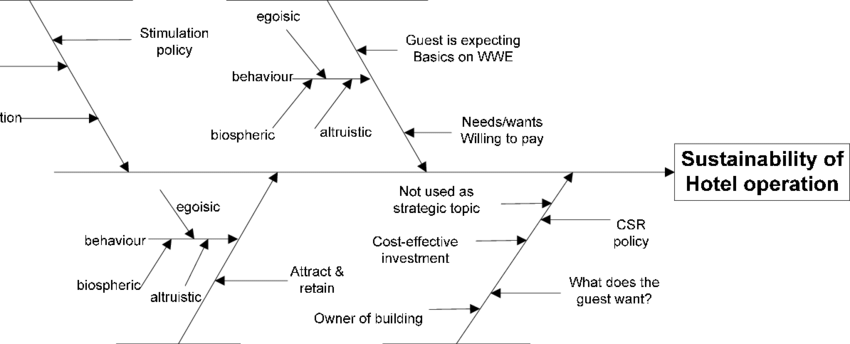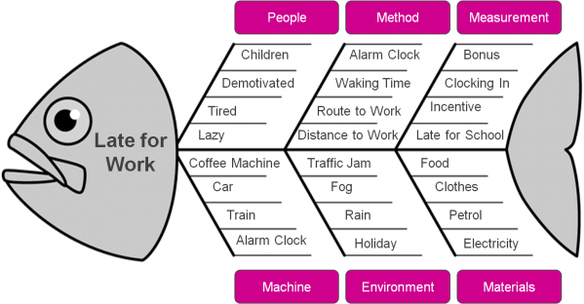Fishbone Diagram
Find The Causes To Effects

A Fishbone Diagram is also called as Ishikawa Diagram or Cause and Effect Diagram. It gets its name from the fact that the shape looks like a fish skeleton. This diagram is a common tool used for a cause and effect analysis, where you try to identify possible causes for a certain problem or event.
The purpose of fishbone diagram or a cause and effect analysis is to identify the causes, factors, or sources of variation that lead to a specific event, result, or defect in a product or process. A fishbone diagram is simply a tool to be used along with Brainstorming and the 5 Ws.
In a fishbone diagram, the various causes are grouped into categories and the arrows in the image below indicate how the causes cascade or flow toward the end effect. Due to its simplicity, the diagram is often drawn on a white board during a brainstorm session
Steps To Using A Fishbone Diagram

Define the Effect: Be specific.
Choose Categories: The fishbone diagram template is set up with the most common set of categories, but you can add or remove categories based on your specific case.
Brainstorm Possible Causes: Using the fishbone diagram while brainstorming can both broaden and focus your thinking as you consider the various categories in turn.
Ask Why?: You really want to find the root causes, and one way to help do that is to use the 5 Whys technique: asking "Why?" or "Why else?" over and over until you come up with possible root causes. "Improper handling" is not a root cause, while "Failing to wear Latex gloves" might be closer to a root cause. But, you could still ask "Why was he/she not wearing gloves?" with the possible response "There were none available." It is a lot easier to take action against the inventory problem than just the generic "improper handling".
Investigate: Now that you've come up with possible causes, it is time to go gather data to confirm which causes are real or not.
Categorization vs. Causality

During a brainstorm session, a fishbone diagram is usually used very loosely, meaning that sometimes may actually represent sub-categories of causes rather than actual causality.
When a cause and effect diagram is used to represent causality, then the primary and secondary branches taken on very specific meanings:
A Primary Cause is one that could lead directly to the effect. For example, a light bulb that burns out pre-maturely (the effect) might be caused by a sudden jarring motion such as dropping, which might be listed under the category People if it was associated with handling by a person (as opposed to machine handling).
A Secondary Cause is a cause that could lead to a Primary Cause, but does not directly cause the end effect. For example, the cause slippery hands doesn't make the bulb burn out, but it could lead to the light bulb being dropped. So slippery hands would be listed as a secondary cause under dropping.
When a fishbone diagram is used for simply categorizing possible causes, then instead of listing Dropping in the place of a primary cause, it might be listed under the sub-category Improper Handling, with Dropping and Throwing as different causes that fit under that sub-category. The following example shows the sub-categories highlighted.
A tree diagram, probability tree, or root cause analysis is geared more towards thinking in terms of causality, while using a fishbone diagram tends to make people think in terms of categorization. Using the fishbone diagram loosely may result in a combination of the two approaches as the group oscillates between categorizing different causes and asking "Why?" or "Why else?".
Just as the main categories (Equipment, People, etc.) are highlighted by placing a circle or box around them, if you include sub-categories in your cause-and-effect diagram, circle the sub-category so you can distinguish between categorization vs. causality.
Fishbone Diagram is great tool although too simple to use and too often ignored to use. It actually helps to solve many problems personal as well as professional.
Fishbone Diagram or Cause & Effect Diagram is one of the important tools in the first phase of Six Sigma Project i.e. Define. So it should be thoroughly used to get the best possible insights.